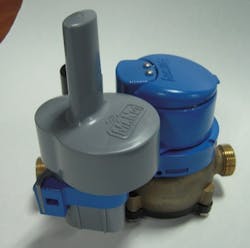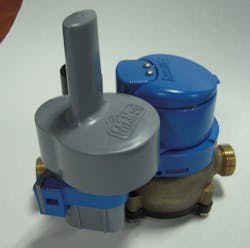Hybrid Lithium Batteries Powering Automated Metering Infrastructure
The majority of water meters used in automated meter reading (AMR) systems and automated metering infrastructure (AMI) are powered by lithium thionyl chloride (LiSOCL2) batteries. While there are many different lithium chemistries, LiSOCl2 batteries offer the highest specific energy (energy per unit weight) and energy density (energy per unit volume) of all existing battery chemistries.
By Sol Jacobs
Automated Meter Reading (AMR) and Advanced Metering Infrastructure (AMI) technologies are gaining momentum in the water utility market, with nearly half of all water meters in North America now equipped with AMR/AMI devices.
AMR/AMI technology has been available since the mid 1980s. However, the pace of industry-wide adoption has accelerated in recent years due to a combination of factors: increased product functionality, extended battery life, and greater affordability due to growing price competition among major AMR/AMI equipment manufacturers.
The vast majority of top-rated AMR/AMI-enabled water meters are powered by lithium thionyl chloride (LiSOCL2) batteries. While there are many different lithium chemistries, LiSOCL2 batteries offer the highest specific energy (energy per unit weight) and energy density (energy per unit volume) of all existing battery chemistries. One reason for the high energy density is lithium’s large electric potential, which exceeds that of other metals, and which produces the high voltages typical of lithium batteries (2.7-3.9 vDC). Lithium cells use a non-aqueous electrolyte, which enables certain batteries to operate in extreme temperatures (-55°C to 125°C).
Lithium primary LiSOCL2 cells are constructed two ways: bobbin-type and spiral-wound. Bobbin cells are best suited for AMR/AMI applications because they combine the highest energy density, the highest voltage, a wide temperature range, and an exceedingly low annual self-discharge. Bobbin cells consist of an outer cylinder made of lithium metal and an inner electrode that is reminiscent of a bobbin of thread.
Spiral-wound cells use flat sheets of metal wound around a core, providing a large surface area that can create high currents. The greater number of layers within the spiral-wound cell reduces the volume of electrolyte these batteries can hold, whereas bobbin cells can hold more electrolyte, enabling them to deliver about 30% more energy than spiral cells of equivalent size.
Bobbin-type cells were first used by Aclara (formerly Hexagram) in their earliest generation of AMR meters, which were introduced back in 1984. Millions of these units are still in operation, the earliest of which are still operating on their original Tadiran battery after 27 years in the field. The proven track record of LiSOCL2 batteries allows today’s AMR/AMI equipment manufactures to offer longer term performance contracts that enhance the cost feasibility of large scale infrastructure upgrades.
New Battery Design
AMR/AMI networks are becoming increasingly complex and feature-rich, exemplified by “On Demand” 2-way RF communications that require high current pulses for data gathering and transmission. To address this growing need, Tadiran developed the PulsesPlus™ battery, which combines a standard bobbin-type LiSOCL2 battery with a patented Hybrid Layer Capacitor. This combination allows advanced metering devices to operate continuously with low background current, periodically drawing high current pulses for data capture and transmission, then returning to a low current “sleep” or “standby” state.
Another unique feature of the PulsesPlus battery is its voltage curve, which offers the potential for systems to be programmed with an end-of-life notification that permits preventative maintenance through scheduled battery replacements. The batteries are available in a 3.6V system that indicates when approximately 95% of the battery’s capacity has been exhausted, and a 3.9V system that indicates when approximately 90% of available battery capacity has been used up.
Combining advanced AMR/AMI technology with PulsesPlus batteries can offer tangible benefits to water utilities and their customers. An example is Mueller Systems’ Mi.Net™ Infrastructure Network for Utilities, which offers a comprehensive solution that integrates the entire meter-reading-to-billing process, allowing utilities to link meters, distribution sites and control devices into a single, flexible and scalable data network.
A critical component of the Mi.Net System is the Mi.Node™ water meter interface unit, which provides full, 2-way communications between the system’s Mesh/Fixed AMI system and the smart meter. Data from the meter is temporarily stored within Mi.Node’s internal memory, then transmitted “On Demand” or at specified intervals via an unlicensed radio frequency channel to a Mi.Gate™ collector, which relays the data to the Mi.Net System’s host server.
Mi.Node interface units are often installed in underground pits, so the unit’s design incorporates multiple moisture barriers to provide a watertight solution. This robust construction, combined with Tadiran’s battery technology, enables Mueller Systems the confidence to offer a 20-year product warranty.
The interface units are also designed to provide automatic notification of low battery status, enabling scheduled battery replacements that can extend the operational life of the system well beyond the 20-year warranty period. This preventative maintenance step further improves the cost-benefit calculations that make long-term investments in advanced AMR/AMI network installations even more attractive.
WW
About the Author: Sol Jacobs is Vice President & General Manager for Tadiran Batteries. Jacobs has over 25 years of experience in developing solutions for powering remote devices. His educational background includes a BS in Engineering and an MBA.
More WaterWorld Current Issue Articles
More WaterWorld Archives Issue Articles


